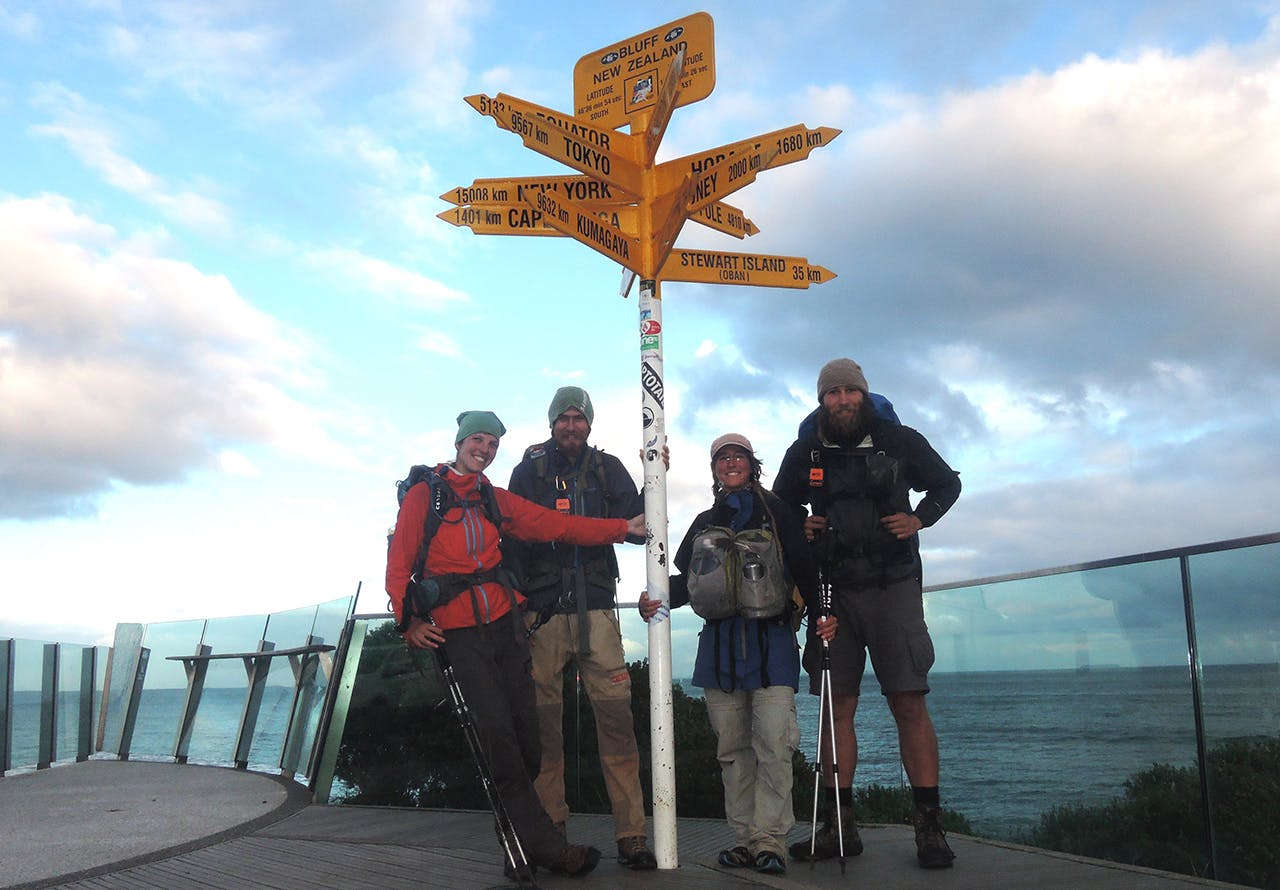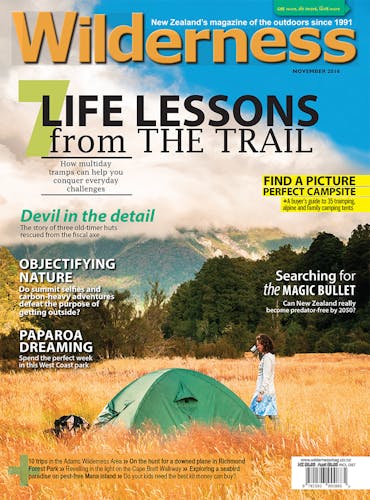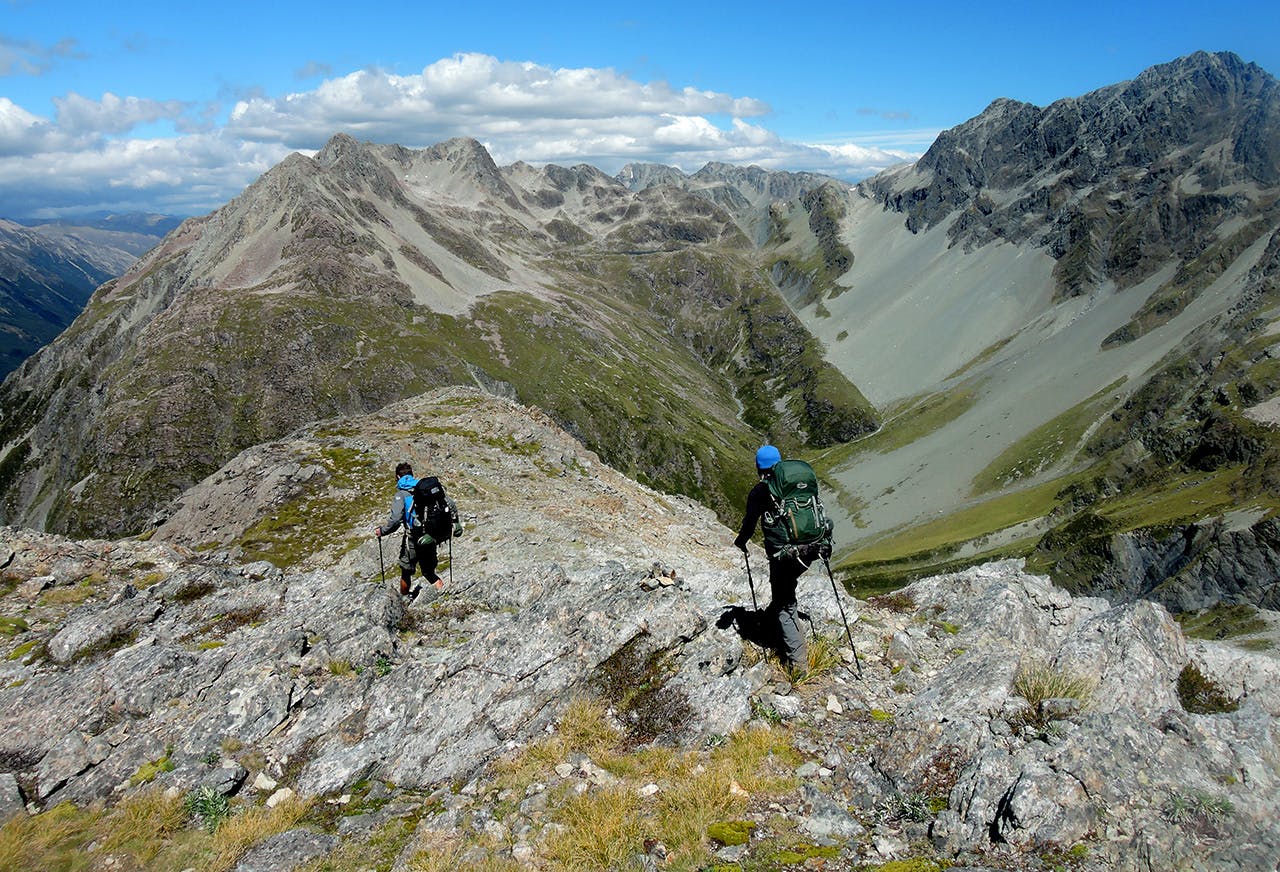How overcoming the tests and challenges of a multiday tramp can help you deal with the ups and downs of everyday life. By Marylene Coutret
I stood there for a while, on the edge of a massive scree slope far above the raging Timaru River, trying to muster up enough courage to take the next step. The track in front was barely wider than my feet, a thin slanted line covered with loose rocks. Despite the brisk morning air, sweat dripped down my back. Focusing on every step, I walked slowly, each movement of my body calculated with care. My legs quivered but didn’t give out. I inched my way forward, but didn’t freeze up and I finally made it across.
And all the way to Bluff.
Last year, I spent five months walking the Te Araroa Trail. It was a life-changing experience. Negotiating the perilous sidle above the Timaru River was one of many thrilling moments. The duration and challenge made for an amazing journey, something I expected from the beginning.
What I didn’t expect was the way it would change my life. My ‘normal-life’, I mean. The one where I have to work eight hours a day, five days a week instead of walking all day; the one where I live in a small cabin, not in a tent. In this daily grind, the experience of the trail – and not just Te Araroa, but any multiday tramp – resurfaces as life lessons.
1. Get out of your comfort zone
Two months after finishing the trail, I found myself sitting in front of a combative interrogator at a job interview. His ice-cold eyes froze my enthusiasm, his scalding questioning technique melted my confidence. I suffered the same sweaty palms and wobbly knees I felt on the scree slope. But thanks to the stamina gained from the trail, I dealt with my anxiety more effectively. I kept my calm in a challenging situation.
Thru-hiking the length of New Zealand pushed me out of my comfort zone. When confronted with new situations, I had to tap into my inner resources, overcome my fears or anxiety and push my own limits. As a result, the number of things I am more comfortable with in normal life has increased. It helped me grow as a person and perceive challenges and opportunities in a different way.
And what about that job? Well, I did survive the three-day trial that followed, but ended up working somewhere else that suited me better. In the long run, getting the job wasn’t that important. What mattered was going through a challenging situation I would have normally avoided.
Andrew, a 47-year-old thru-hiker from Canada, agreed: “I never appreciated how much control fear and anxiety had over my life until I was many, many weeks on the trail,” he said.
2. Know that tough times don’t last
Some lessons only seemed apparent after several weeks, others much more quickly. Six days into the trail, I reached the Herekino Forest Track. Feeling like a rookie in a battlefield, I trudged through thick mud for hours, up and down steep slopes, fearing that this nightmare would never end.
Immediately after Herekino Forest came Raetea Forest Track: longer, steeper and dispiritingly muddier. But even if the battlefield was worse, the rookie was better prepared. I knew that sooner or later, the knee-deep puddles would vanish; every step took me closer to the end of that sticky ordeal.
Tough times don’t last. Everything is temporary, just like a bad day at work behind my coffee machine. I work as a barista in a bakery, a job that is not always about the aromatic smell of roasted beans and freshly baked croissants. For example, when the printer fires out dockets like a machine-gun and I spill my jug of milk before a fuming customer, giving me a stare as abrasive as the burrs of a grinder, I repeat to myself, “this won’t last”.
One order after another, I make progress; each docket is like a step on the track, there and gone.
3. Take one step at a time
Before setting off on this adventure, I periodically found myself overwhelmed by the magnitude of what I was about to do. Unless you have the courage to follow John Muir’s free spirit and just ‘throw some tea and bread into an old sack and jump over the back fence’, such a trip requires serious preparation.
For about eight months, I read everything I could about the trail. It looked like a mountain of paper, with boulders of information crashing down from it: 3000km, five to six months, weather, navigation, resupply, gear…. How could I possibly walk the length of a country?
It left me with just enough energy to crawl back to bed.
But I started from Cape Reinga with a simple objective: to get to Ahipara, four days away and the first resupply point. Then, from Ahipara to Kerikeri. And so on. Breaking the trail into smaller sections helped me focus on one section at a time. By putting one foot in front of the other, I ended up walking 3000km.
I put this philosophy into use when I try and learn a new song on the guitar. The tab for ‘Tears in Heaven’ by Eric Clapton can look intimidating, but string by string, fret by fret, my fingers become familiar with the melody. Step by step, anything can be accomplished.
4. Be persistent in the pursuit of your goals
Persistence is the key to get to the end of a 3000km hike. Rob, a hiker from England, spent eight days in Auckland Hospital due to a severe case of giardia. Andrew broke his ankle two weeks before finishing the trail, in March, but that same week booked his flight to return and complete the trail in December. Patrick, a hiker from California, was stranded in Hamilton for a week because of shin splints. They all eventually made it to Bluff.
Many times the ‘Give up’ sign flashed in my mind. Wet from endless rain showers and in pain, I envied the people sitting comfortably in their homes, watching TV, cooking dinner. “What am I doing here? Why am I doing this?” I thought, my mood as grey as the concrete of the South Auckland suburb I was traversing.
But I pushed through. I chose to be there. And at the end of the day, pitching my tent by a waterfall with other friendly hikers, I came to realise that those people – the “sedentary people”, as we called them – would watch TV instead of the sunset, and fall asleep to the noise of traffic instead of a singing stream. Giving up simply wasn’t an option.
Perseverance has always been a strength of mine. After my first trip to New Zealand in 2008, the idea of exhibiting my travel photos settled in my mind, but I was absolutely clueless about how to proceed. From town halls to libraries, I kept asking. My exhibition finally took place in Belfort (France) in September 2009, as a grant-aided Youth Art Project.
Walking the Te Araroa was a great reminder of that strength.

Evelyne, Per-Jonas, Marylene and Patrick celebrate arriving at Bluff – all felt walking the trail had changed them for the better. Photo: Marylene Coutret
5. Learn to live in the now
I tend to be a ‘worrier’, and at first couldn’t help but feel anxious about how the day would unfold. What would the weather be like, would I have enough food, would I find a safe place to camp?
After a few weeks, I began to understand that my worries were unjustified. Practising mindfulness and focusing on the present helped me appreciate every moment of the trail rather than worrying about the future.
Every moment, whether it was thrilling or quiet: a cup of tea warming my hands, a small triangle of the world brightening up through the door of my tent. There was nothing else.
Now, my 4am alarm might as well be the starter’s pistol at a track and field race; and me an athlete at the breakfast pentathlon. So much for being in the moment.
Today’s society compels us to a faster pace of life. Yet, thinking about these quiet mornings on the trail, I remind myself to take the time to slow down.
Other hikers also experience this gap between trail life and everyday life.
“I feel like I have lost some of that mindfulness in current life,” explained Evelyne De Boeck, a 27-year-old hiker from Belgium. “I worry about making the wrong choices. But when I do go out again I can live entirely in the moment, and regain this practise of inner reflection. When I go into the mountains, I know that I can find myself.”
6. Know when to let go
If persistence is primordial, the line between relentlessness and stubbornness is a thin one.
I also had to learn when to let go. Clinging to a tree on the edge of a precipitous cliff, I scanned the rock in search of a path through the cold horizontal rain and thick fog. In vain.
Climbing the Te Whara Track at Whangarei Heads, I had followed the orange markers; I rebuffed the idea of being lost. But unless I grew wings, there was no way I could carry on. I had to turn back, which meant going down the 500 vertical metres and who knows how many steps I had just clambered up.
Thankfully, I stumbled upon the right path on my way down – I had followed the side track to the Te Whara Lookout: a dead end. This adjective would have applied to me if I had stubbornly tried to go on.
So now if I happen to get stuck behind a line of traffic as long as the Waikato River, I know there’s no need to try and pass them all. Being late is not a big deal.
7. Learn to reconnect with yourself
Walking for such a long time, immersed in nature, and mostly on my own, cultivated another beneficial aspect: I was notably disconnected from the world, with no TV, no Internet access, very little time in towns, and therefore much more connected with myself.
Walking leads to inner contemplation, and I got to do a lot of soul searching. I have witnessed striking changes in some of my fellow hikers due to their experience and time on the trail.
“I came away with a healthier perspective on myself and the way I have lived much of my life,” Andrew confessed. “I gained strength and confidence to make changes to my circumstances to the benefit of myself and others.”
Evelyne revealed she also felt a notable transformation along the way. “I have never felt as good about myself, as confident, as I did in the final two months of the Te Araroa.”
Most of the thru-hikers I met have done, or are planning on doing, another long-distance walk. And most of them, in the meantime, had to go back to the routine of a working life.
I enjoy the consistency found in the routine of everyday life, as long as I know it is temporary, the necessary gestation of the next adventure. This everyday routine can be sometimes easy or sometimes difficult, depending on the circumstances, but walking the Te Araroa Trail has definitely been a great influence on how I lead my life now.
If fulfilling your daily obligations feels at times like standing on the edge of a scree slope above a raging river, just take a walk. You might come back changed.
– Marylene Coutret hails from France but now lives in Motueka.







